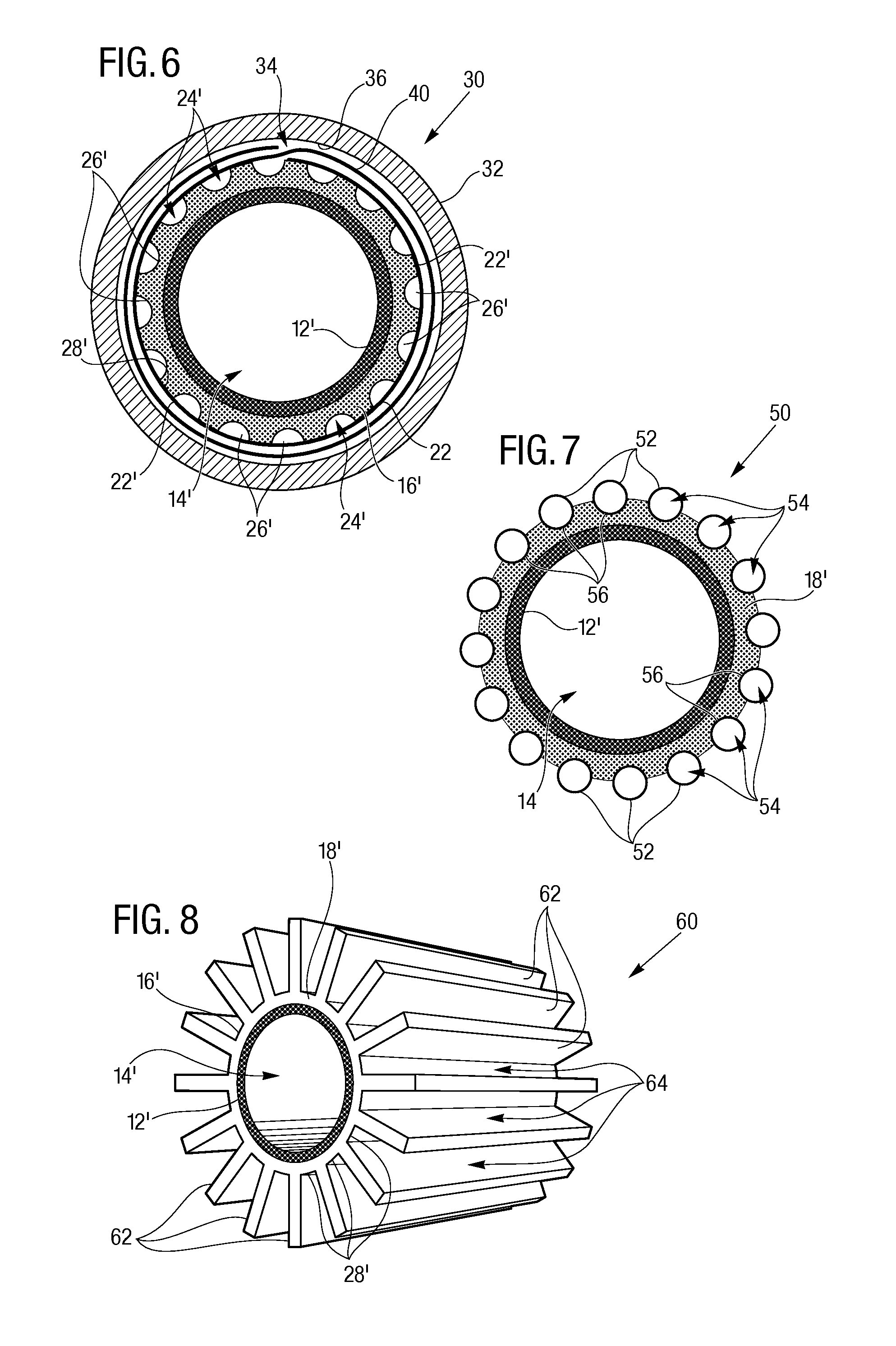Extreme environment heat exchanger
a heat exchanger and extreme environment technology, applied in the field of heat exchangers, can solve the problems that the machining of such extreme environment heat exchanger components becomes exceptionally difficult, and achieve the effect of reducing the rate of heat transfer, effectively concentrating heat within the coil, and minimizing the thermal expansion of the surrounding metal pip
- Summary
- Abstract
- Description
- Claims
- Application Information
AI Technical Summary
Benefits of technology
Problems solved by technology
Method used
Image
Examples
embodiment 30
[0030]The displaced metal pipe embodiment 30 may also include a plurality of portions 26′ of cool fluid passages 24′ defined within the exterior surface 28′ of the heat transfer layer 16′. This increases the exterior surface area 28′ of the heat transfer layer 16′ exposed to a cooling fluid passing through the surrounding cool fluid passage 34 and / or the cool fluid passages 24′ that are defined between the metal pipe 32 and exterior surface 28′ of the heat transfer layer 16′.
[0031]The displaced metal pipe embodiment 30 may also include a metal coil seal 40 secured between the exterior surface 28′ of the heat transfer layer 16′ and the interior surface 36 of the metal pipe 32. The coil seal 40 may not be bonded or otherwise permanently secured to the exterior surface 28′ of the heat transfer layer 16′. The coil seal 40 (as shown in FIG. 6) overlaps itself and therefore enables differential thermal growth or physical expansion of the coil seal 40 between the heat transfer layer 16′ an...
embodiment 50
[0033]FIG. 7 shows a multi-tube embodiment 50 of the extreme environment heat exchanger 10. This embodiment 50 includes a plurality of metal pipes 52, wherein each metal pipe 52 defines a complete cool fluid passage 54. Each metal pipe 52 is also secured adjacent to and coextensive with the heat transfer layer 16′. A further aspect of this embodiment includes the exterior surface 28′ of the heat transfer layer 16′ defining a plurality of channels 56 configured so that each of the plurality of metal pipes 54 is secured within each of the plurality of channels 56 to increase a rate of heat movement between the heat transfer layer 16′ and the cool fluid passages 54 defined by the metal pipes 52. Additionally, the metal pipes 52 may be bonded within the channels 56 to further increase a rate of heat movement or transfer, so that the metal pipes 52, heat transfer layer 16′ and the hot fluid conduit 14′ defined by the ceramic matrix composite 12′ form an integral, multi-tube extreme envir...
embodiment 60
[0034]FIG. 8 shows a heat-discharge extension embodiment 60 of the extreme environment heat exchanger 10. This embodiment 60 includes a hot fluid conduit 14′ defined by a ceramic matrix composite 12′ and surrounded by a coextensive, heat transfer layer 16′ of hardenable material 18′. The heat transfer layer 16′ also defines a plurality of heat discharge extensions 62 extending from the exterior surface 28′ of the heat transfer layer 16′ and away from the hot fluid conduit 14′. A plurality of cool fluid passages 64 are defined between the heat discharge extensions 62. The heat discharge extensions 62 may take the form of fins and pins defined by the hardenable material 18 with the above described high thermal conductivity, such as metals including silicon, silver, copper, aluminum, nickel, nickel alloys. A length of extension of the heat discharge extensions away from and perpendicular to the hot fluid conduit 14′ may be between about one-half and about ten times a wall thickness of ...
PUM
| Property | Measurement | Unit |
|---|---|---|
| temperatures | aaaaa | aaaaa |
| thickness | aaaaa | aaaaa |
| thickness | aaaaa | aaaaa |
Abstract
Description
Claims
Application Information
 Login to View More
Login to View More - R&D
- Intellectual Property
- Life Sciences
- Materials
- Tech Scout
- Unparalleled Data Quality
- Higher Quality Content
- 60% Fewer Hallucinations
Browse by: Latest US Patents, China's latest patents, Technical Efficacy Thesaurus, Application Domain, Technology Topic, Popular Technical Reports.
© 2025 PatSnap. All rights reserved.Legal|Privacy policy|Modern Slavery Act Transparency Statement|Sitemap|About US| Contact US: help@patsnap.com



